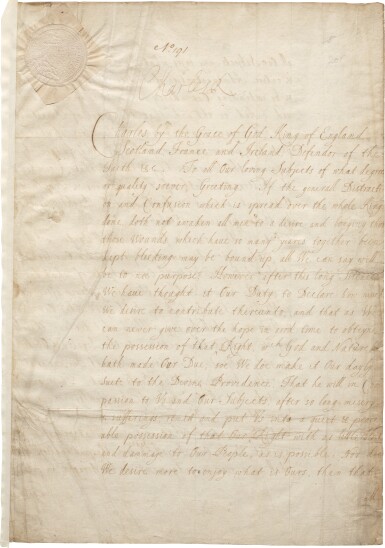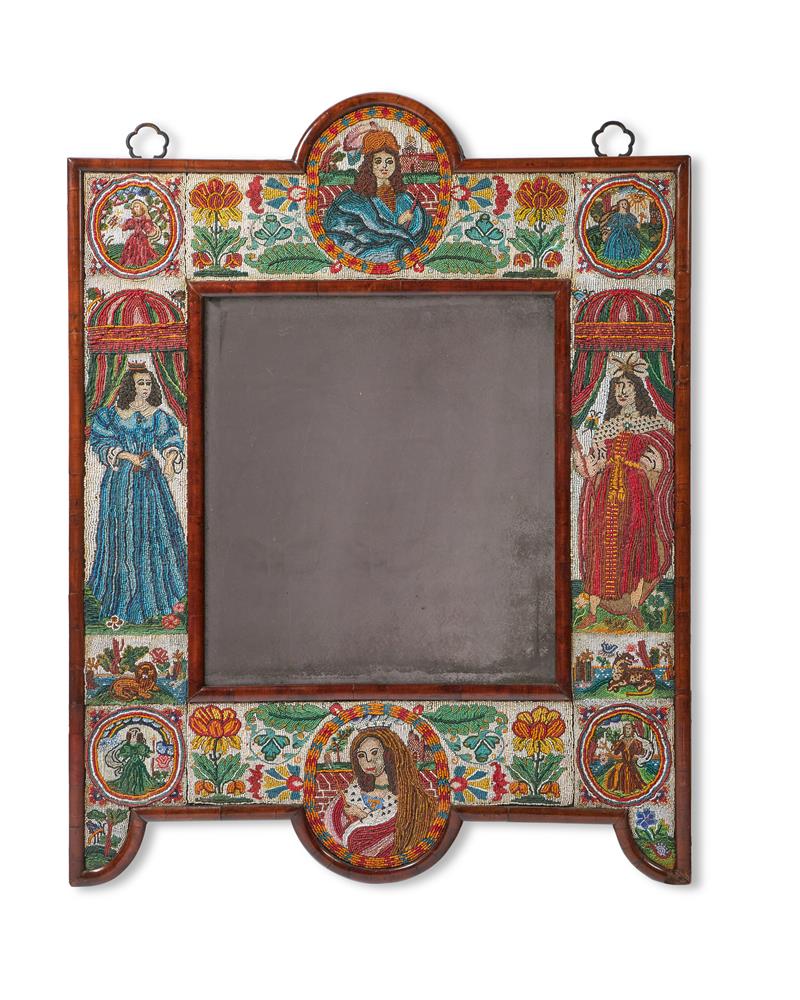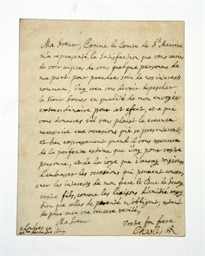Y A CHARLES II PAINTED OAK, MOTHER OF PEAR AND BONE INLAID ENCLOSED CHEST OF DRAWERS CIRCA 1660 With cushion frieze drawer above a deep drawer, the cupboard doors to the base enclosing an arrangement of three further drawers 136cm high, 115cm wide, 66cm deep Provenance: Sidney Edward Letts (1868-1940) Sold to Leonard and Maud Messel for the Sitting Room at 104 Lancaster Gate Thence by descent to Oliver Messel Supplied by Oliver Messel to Frederick and Phyllis Watkins for Flaxley Abbey This mother-of-pearl, bone-inlaid and painted oak chest-of-drawers was in the collection of Leonard and Maud Messel, parents of Oliver Messel in [approx. date of photograph] where it was photographed in the Drawing Room at their London home at 104 Lancaster Gate (private collection). Enthusiastic collectors throughout their lives, this chest-of-drawers was almost certainly purchased by them from the London antique dealer and maker of reproduction furniture, Sidney Edward Letts (1868-1940) of 98 Great Russell Street, London, who owned this chest in c. 1904-08 when it was illustrated in Percy Macquoid's The Age of Oak (London, 1904-08, reprinted 1989, pp. 76-77, fig. 141). As a young man, Oliver was surrounded by artists, collectors, connoisseurs and scholars in the 'rarefied and exotic world' of his parents (T. Messel, Oliver Messel in the theatre of design, New York, 2011, p. 18). Fashionable dealers and interior decorators of the period were also among the visitors to Lancaster Gate, Balcombe House and, from 1915, Nymans in West Sussex. Mr. Lenygon of Lenygon and Morant, specialists in period interior rooms, would take Oliver 'on fascinating expeditions through a maze of Dickensian streets to see marvellous materials being woven in Hogarthian surroundings, secret havens for fringes, gimps and tassels, master wood-carvers, gesso work, gilders, glass-blowers and engravers' (ibid., p. 24). The chest-of-drawers has mouldings applied to the facade in geometrical patterns, which are architectural in spirit. The advent of the 17th century chest-of-drawers in England, often made in two parts, is a testament to the skill of the joiner before he was replaced by the cabinet-maker in 'the creation of fashionable furniture (Benno M. Forman, 'The origins of the joined chest of drawers', Nederlands Kunsthistorisch Jaarboek (NKJ) / Netherlands Yearbook for History of Art, Vol. 31, 1980, p. 170). It derives from continental prototypes such as the Netherlandish Zeeland Kast although it differs in that it has drawers rather than shelves. Such chests-of-drawers are identified in the London inventories of the middling sort rather than urban aristocrats or rural gentry. The inlaid mother-of-pearl and bone decoration was common on the stocks of guns made in London in the 16th century (ibid., p. 172) although the ornamentation of English chest-of-drawers is composed of larger pieces of inlay and the patterns are looser possibly undertaken by emigré craftsmen working in London (ibid.). While the bone and mother-of-pearl inlay of this chest-of-drawers is probably original, the painted ornamentation in the Neo-Renaissance style, together with the carving on the cornices and feet and the drawer handles, are almost certainly a later enhancement - possibly dating to the late 19th / early-mid 20th century. In general, no English 17th century example has carved or relief ornamentation (ibid.). Furthermore, it is unusual for not having turned half-spindles suggesting engaged architectural columns. Other examples are at: Towneley Hall Museum and Gallery, Burnley; Benthall Hall, Shropshire and Montacute House, Somerset (A. Bowett, English Furniture 1660-1714: From Charles II to Queen Anne, Woodbridge, 2002, p. 50, Plate 2:29; NT 509680 and NT 597546). Interestingly, there is a Carolean chest-of-drawers inlaid with bone and mother-of-pearl at Parham Park. At Parham, Oliver Messel was advising Clive Pearson on the interiors and prior to this Pearson was buying furniture from Sidn
Y A CHARLES II PAINTED OAK, MOTHER OF PEAR AND BONE INLAID ENCLOSED CHEST OF DRAWERS CIRCA 1660 With cushion frieze drawer above a deep drawer, the cupboard doors to the base enclosing an arrangement of three further drawers 136cm high, 115cm wide, 66cm deep Provenance: Sidney Edward Letts (1868-1940) Sold to Leonard and Maud Messel for the Sitting Room at 104 Lancaster Gate Thence by descent to Oliver Messel Supplied by Oliver Messel to Frederick and Phyllis Watkins for Flaxley Abbey This mother-of-pearl, bone-inlaid and painted oak chest-of-drawers was in the collection of Leonard and Maud Messel, parents of Oliver Messel in [approx. date of photograph] where it was photographed in the Drawing Room at their London home at 104 Lancaster Gate (private collection). Enthusiastic collectors throughout their lives, this chest-of-drawers was almost certainly purchased by them from the London antique dealer and maker of reproduction furniture, Sidney Edward Letts (1868-1940) of 98 Great Russell Street, London, who owned this chest in c. 1904-08 when it was illustrated in Percy Macquoid's The Age of Oak (London, 1904-08, reprinted 1989, pp. 76-77, fig. 141). As a young man, Oliver was surrounded by artists, collectors, connoisseurs and scholars in the 'rarefied and exotic world' of his parents (T. Messel, Oliver Messel in the theatre of design, New York, 2011, p. 18). Fashionable dealers and interior decorators of the period were also among the visitors to Lancaster Gate, Balcombe House and, from 1915, Nymans in West Sussex. Mr. Lenygon of Lenygon and Morant, specialists in period interior rooms, would take Oliver 'on fascinating expeditions through a maze of Dickensian streets to see marvellous materials being woven in Hogarthian surroundings, secret havens for fringes, gimps and tassels, master wood-carvers, gesso work, gilders, glass-blowers and engravers' (ibid., p. 24). The chest-of-drawers has mouldings applied to the facade in geometrical patterns, which are architectural in spirit. The advent of the 17th century chest-of-drawers in England, often made in two parts, is a testament to the skill of the joiner before he was replaced by the cabinet-maker in 'the creation of fashionable furniture (Benno M. Forman, 'The origins of the joined chest of drawers', Nederlands Kunsthistorisch Jaarboek (NKJ) / Netherlands Yearbook for History of Art, Vol. 31, 1980, p. 170). It derives from continental prototypes such as the Netherlandish Zeeland Kast although it differs in that it has drawers rather than shelves. Such chests-of-drawers are identified in the London inventories of the middling sort rather than urban aristocrats or rural gentry. The inlaid mother-of-pearl and bone decoration was common on the stocks of guns made in London in the 16th century (ibid., p. 172) although the ornamentation of English chest-of-drawers is composed of larger pieces of inlay and the patterns are looser possibly undertaken by emigré craftsmen working in London (ibid.). While the bone and mother-of-pearl inlay of this chest-of-drawers is probably original, the painted ornamentation in the Neo-Renaissance style, together with the carving on the cornices and feet and the drawer handles, are almost certainly a later enhancement - possibly dating to the late 19th / early-mid 20th century. In general, no English 17th century example has carved or relief ornamentation (ibid.). Furthermore, it is unusual for not having turned half-spindles suggesting engaged architectural columns. Other examples are at: Towneley Hall Museum and Gallery, Burnley; Benthall Hall, Shropshire and Montacute House, Somerset (A. Bowett, English Furniture 1660-1714: From Charles II to Queen Anne, Woodbridge, 2002, p. 50, Plate 2:29; NT 509680 and NT 597546). Interestingly, there is a Carolean chest-of-drawers inlaid with bone and mother-of-pearl at Parham Park. At Parham, Oliver Messel was advising Clive Pearson on the interiors and prior to this Pearson was buying furniture from Sidn






.jpg)







Try LotSearch and its premium features for 7 days - without any costs!
Be notified automatically about new items in upcoming auctions.
Create an alert